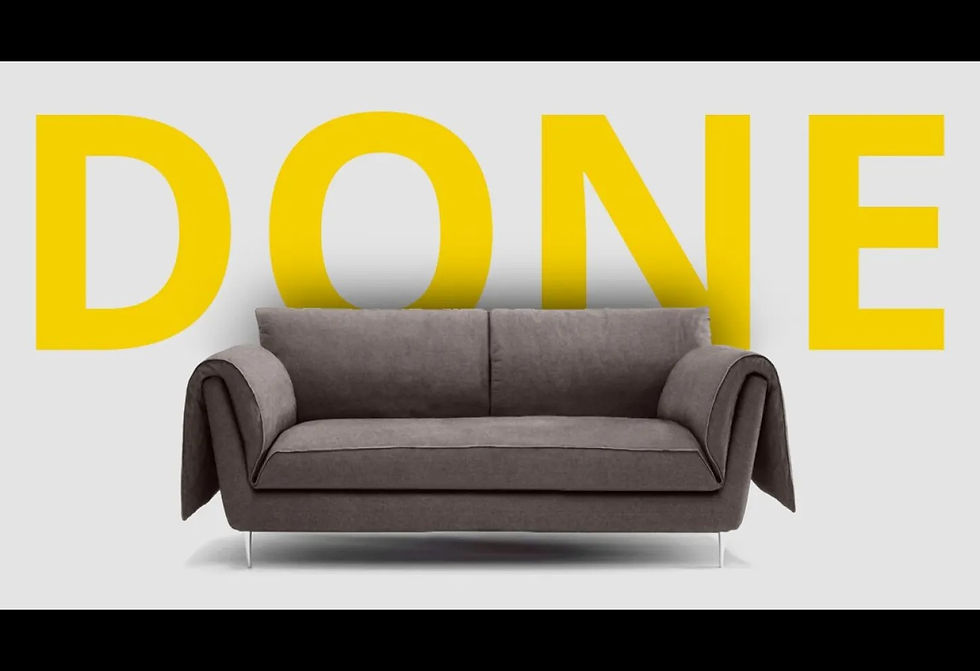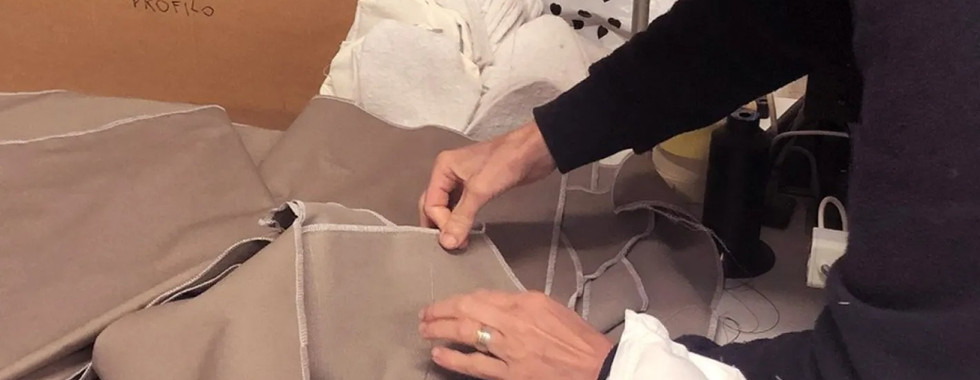How is made? From plant to BIOSOFA - 100% natural sofas
- TuscanyLux

- May 2, 2023
- 4 min read
Design, Planning, and Prototyping
When the designers of Biosofa company come together to develop a new #sofa model, the first step is often #sketching and creating a miniature model. During the meeting, they discuss #comfort, usability, appearance, impression, line, materials, and general emotions to be included in the new sofa. In the picture, the designers present the first model of the Casquet sofa.
Eventually, a 3D #model is created, in this specific case of the Casquet sofa. The product development team then tries to optimize and improve the model, and precisely calculate the sizes of the textile and cutting patterns for use on a large-format plotter.
The digital model also serves as a basis for calculating the cost of production, including all materials and processes. Once everyone involved in the development of the new #sustainable sofa is satisfied, the actual production can begin..
Building the Wooden Frame
All frames of biosofa products are made of solid wood that meets FSC or PEFC certification. For the production, dried beech wood is used as it is an extremely hard and robust material that maintains its shape even after many years of use. The company values the high quality of its products and therefore does not use any harmful materials such as plywood or MDF.
The specialized team of carpenters working for biosofa is proud of their experience and craftsmanship inherited from their fathers and grandfathers.
After manual cutting and sanding of the wooden parts, each piece is carefully measured and assembled by the team led by the carpenter Fabio Solenna. This process creates a complete wooden base frame that forms the backbone of the biosofa couch.
Jute and metal springs
After the installation of the base for the padding, the teams focus on making it not only comfortable but also durable and robust. The base is made up of vertical and horizontal strips of jute, which are attached with steel nails and held together with large steel staples. This elastic layer is a key component that provides the elasticity and comfort of the biosofa.
Another layer of cross straps is applied to the top and inner backrest and attached to steel springs. Once all the components are securely fastened, another piece of clean jute fabric is added to cover the entire network of straps and springs. This process is repeated to make additional layers of fabric and cushioning as smooth as possible.
Cotton felt and latex filling
After layering the latex and felt, another layer of fabric is applied to the entire sofa, which serves as the final cover. This material can be of different types and colors and is carefully selected from a wide range of quality textiles.
Then the entire sofa is assembled and its parts are carefully attached to each other using seams and clips. A final inspection ensures that all joints are really strong and flawless and that the sofa has the desired shape and appearance.
Finally, pillows and other decorative elements are attached to the sofa, which complete it and give it a unique style and character. The result is a sofa that is not only beautiful and comfortable but also robust and long-lasting against wear and tear and use.
Inner filling and outer covering
With the 3D model created at the beginning of the process, precise cuts for the textiles can now be obtained. Shapes specific to each type of sofa are passed to a specialized cutting program, which is connected to an automated large cutting table measuring 3 x 8 meters and with a movable arm. This allows for easy and precise cutting of all materials.
After the textile is perfectly laid out on the cutting table, gentle air pressure from below sucks the textile down and holds it in place throughout the cutting process. Each type of textile has its own unique characteristics and presents certain challenges. For example, with velvet, the placement of the soft surface reflects light differently depending on the direction of the weave.
Once all the textile pieces are cut, skilled seamstresses clean them and assemble the covers, with hems, zippers, and threads tailored to match the textile color.
The first covering is a white protective covering that also supports smooth and perfectly flat movement for the final textile. If the top textile covering of the furniture needs to be removed for cleaning (something the biosofa is rightfully proud of offering as a standard feature), this covering can be seen perfectly. Finally, the chosen textile for the top covering is assembled, which the customer has selected.
Armrests and Cushions
Generally, the backrest of a sofa is softer than the actual seat. Therefore, various techniques need to be used in its production. Clean feathers are used for making the backrest, which makes it practically a cushion within a cushion. To keep the material soft in place, a technique called air-cell insertion is used, which is similar to the production of high-quality down jackets. Upon request, Biosofa also offers a vegan alternative.
The inner layer of the seat is made of a 10 to 20 centimeter thick layer of 100% natural latex. These pieces of latex are finally covered with a feather chamber cushion, similar to the outer part of the backrest.
Quality Control
The last stage of Biosofa production includes assembling the legs and performing a double measurement and verification of the desired properties during quality control. The sofa is also tested for comfort, and each piece is thoroughly documented. For customers, samples of the original cover fabric are also included, which serve as a basis for the selected color, if needed in the future.
After completing all of these steps, a happy smile appears on everyone's face: Biosofa is now ready for shipment and will give you a feeling of satisfaction :)











































Comments